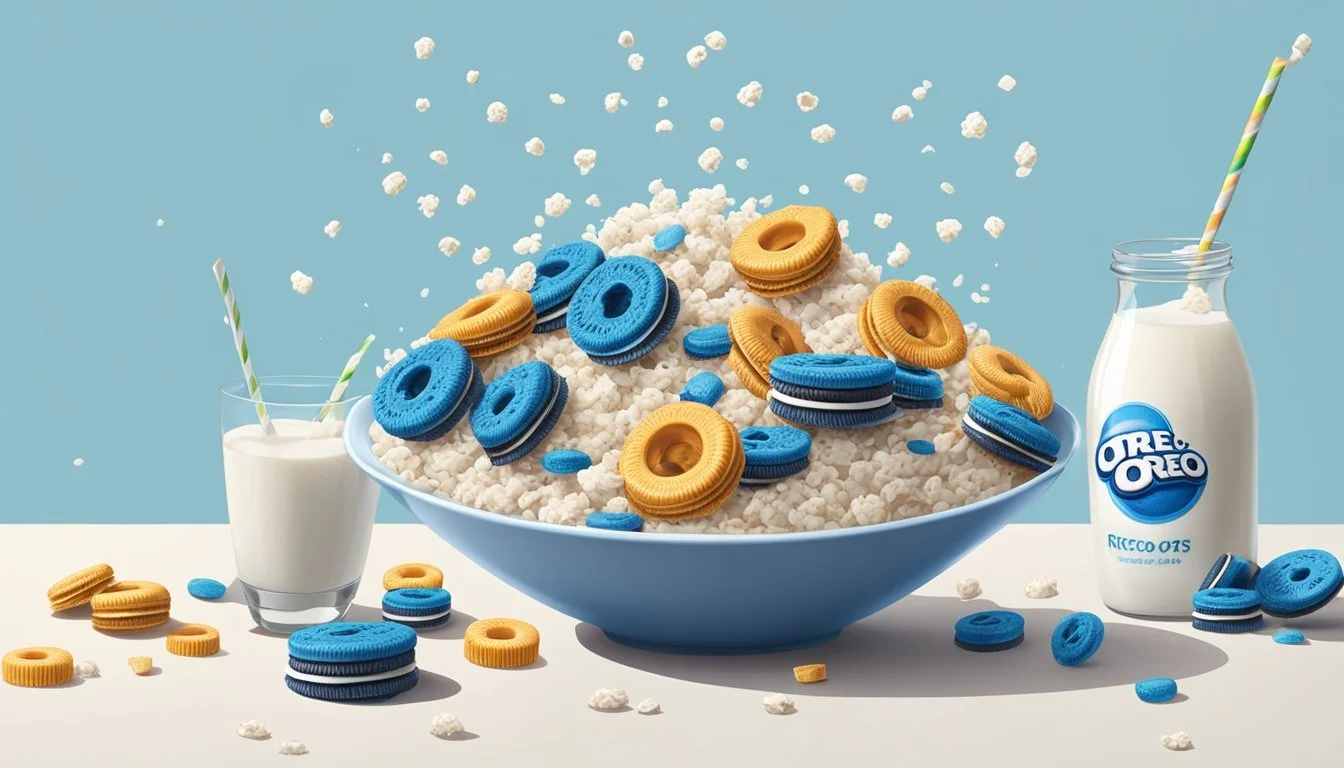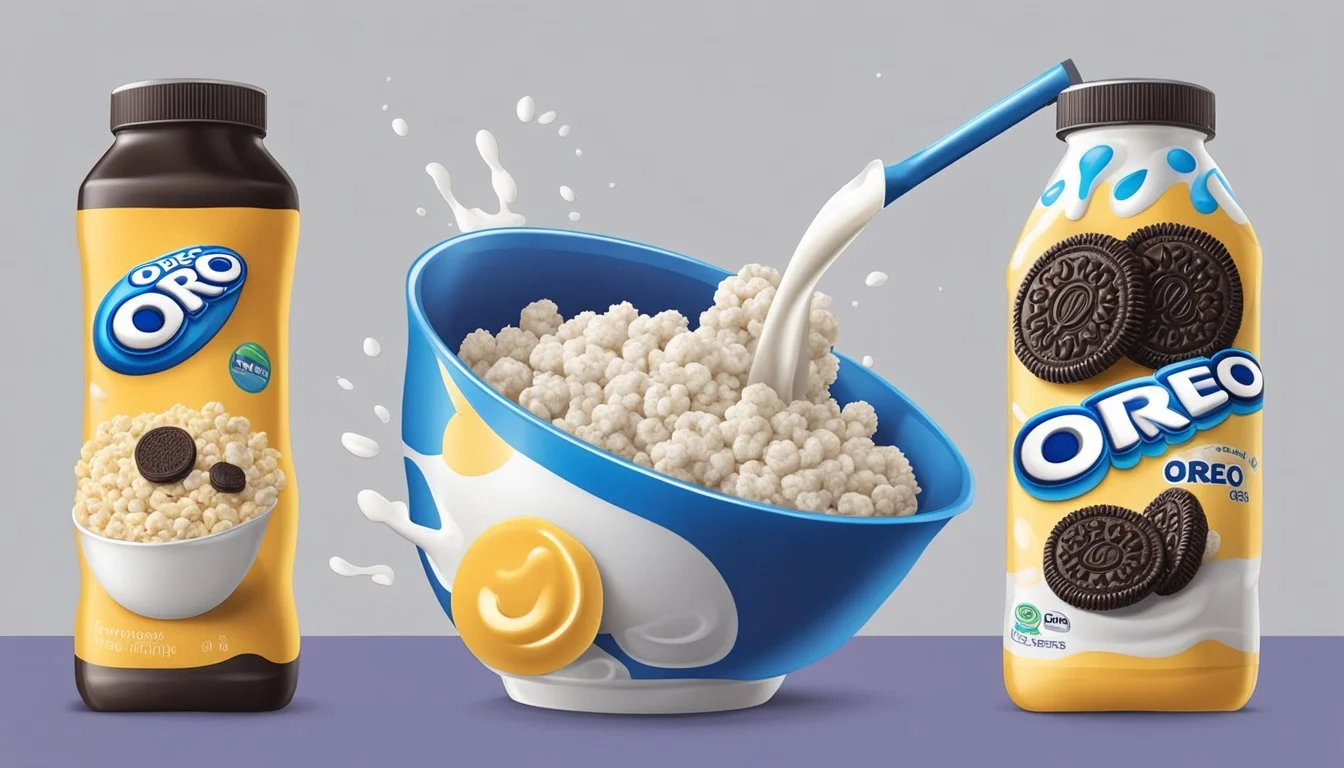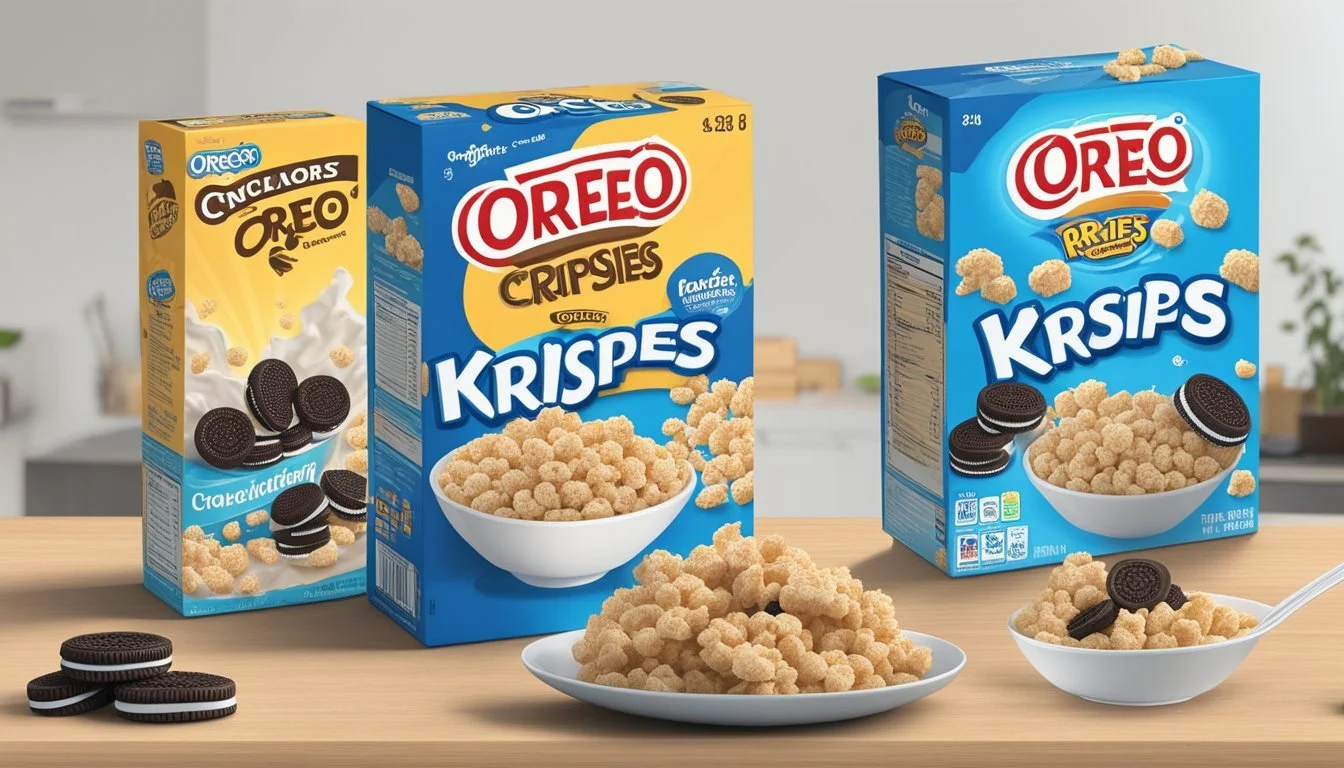Oreo O's vs Rice Krispies
Breakfast Cereal Showdown
This Article is Part of Our Breakfast Cereal Guide with Details on Oreo O's Nutrition and Rice Krispies Nutrition
When it comes to breakfast cereals, Oreo O's and Rice Krispies each bring their unique flavors and textures to the table. Oreo O's are an indulgence for anyone who loves cookies and cream. This cereal offers the bold, sweet taste of Oreo cookies in a crunchy, milk-ready form that pairs perfectly with a morning routine or as an evening snack. These cereal pieces are coated with a sugary glaze that mimics the beloved cookie, making each bite a delightful experience.
On the other hand, Rice Krispies stand out for their simplicity and versatility. Made from toasted rice, they are known for their light, crisp texture and subtle flavor. This makes them a favorite not just for breakfast but also as the base for many dessert creations, like the iconic Rice Krispie treats. Rice Krispies are perfect for those who prefer a less sweet, more traditional cereal option that can easily be adapted for various recipes.
Both cereals cater to different taste preferences and occasions. Oreo O's provide a dessert-like cereal experience that appeals especially to kids and those with a sweet tooth, while Rice Krispies offer a more understated, classic cereal that has stood the test of time both at the breakfast table and in dessert recipes.
History and Evolution
Oreo O's and Rice Krispies have fascinating origins and development stories that highlight their unique places in breakfast cereal history.
Origins of Oreo O's
Oreo O's cereal was introduced to the market by Post Consumer Brands in 1997. It was designed to capitalize on the popularity of the Oreo cookie, a staple in American households.
The cereal featured chocolate-flavored O's that mimicked the taste of Oreos, with a creamy coating to represent the cookie's filling. Despite fluctuating sales, Oreo O's maintained a loyal following. It was discontinued in the U.S. in 2007 due to a split between Kraft (owner of the Oreo brand) and Post. However, the product found a dedicated market in South Korea, where it continued to be sold. In 2017, Oreo O's returned to the U.S. market, much to the delight of cereal enthusiasts, and has remained a popular choice ever since.
Development of Rice Krispies
Rice Krispies cereal, a product of Kellogg's, first appeared in 1928. It quickly gained popularity for its unique texture and snap, crackle, pop sound when combined with milk.
The cereal was created by food scientist Alexander Anderson, who innovated the puffed rice technique. Throughout the years, Rice Krispies have expanded beyond breakfast cereal. In 1939, Mildred Day and Malitta Jensen, working at Kellogg's, developed the iconic Rice Krispies Treats. They combined the cereal with marshmallows and butter, revolutionizing the snack world. Rice Krispies cereal and its treat adaptations, trademarked in 1940, have since become a staple in households and inspired numerous variations.
Nutritional Comparison
The nutritional profiles of Oreo O's and Rice Krispies differ in several aspects, particularly in calorie content, sugar and fat composition, and vitamin and mineral content. These variables can influence individual dietary choices based on personal health goals.
Calorie Content Analysis
Oreo O's are higher in calories, often due to additional ingredients that enhance their flavor. Per serving (1 cup):
Oreo O's: ~170 calories
Rice Krispies: ~130 calories
Calories primarily come from carbohydrates in both cereals, but Oreo O's may have extra calories from added sugars and fats. Lower-calorie cereals like Rice Krispies can be preferable for those on calorie-restricted diets.
Assessment of Sugar and Fat
The sugar content in Oreo O's is significantly higher than in Rice Krispies. This difference impacts overall caloric intake and can affect energy levels.
Oreo O's: 13g of sugar, 2g of fat, 0.5g saturated fat
Rice Krispies: 4g of sugar, 0g of fat, 0g saturated fat
High sugar levels in Oreo O's can contribute to increased blood glucose levels. For those watching their fat intake, it is important to note that Oreo O's contain more fat, although the amount of saturated fat remains low.
Vitamins and Minerals Content
Both cereals contain essential vitamins and minerals, but the quantity and variety differ. Oreo O's tend to have added nutrients to attract consumers looking for fortified options.
Oreo O's: Enriched with Vitamin A, Vitamin C, Calcium, and Iron
Rice Krispies: Primarily fortified with B-Vitamins (B1, B2, B3, B6, B12) and Iron
These vitamins play crucial roles in metabolism and energy production. The iron content is particularly useful for preventing deficiencies. Consumers seeking specific nutrients might favor one cereal over the other based on their dietary needs.
Key Ingredients Breakdown
Exploring the key ingredients of Oreo O's and Rice Krispies treats reveals interesting differences and similarities that impact their flavors and textures. Highlighted components include cereals, marshmallows, and the crucial role of butter or oils.
Examining Cereal Content
Oreo O's are primarily composed of Oreo-inspired cereal pieces. These are typically chocolate-flavored and have a distinctive crunch, aiming to replicate the classic Oreo taste.
Rice Krispies, on the other hand, are made from puffed rice cereal, which provides a light, airy texture. It acts as a versatile base, allowing other ingredients to shine.
Both cereals are low in fat but may have differing levels of added sugar and flavorings, affecting the overall nutritional profile.
Importance of Marshmallows and Chocolate
Marshmallows play a significant role in Rice Krispie treats. They melt to create a gooey binding for the cereal pieces. This sticky texture is crucial for the treat's unique chewiness.
In the case of variations like Oreo Rice Krispie treats, chopped Oreo cookies are mixed in, adding pockets of crispy chocolate goodness and altering the textural experience.
Chocolate adds a rich, indulgent note to both treats. For Oreo O's, the inherent cereal flavor suffices, but Rice Krispie treat recipes may incorporate additional chocolate chips or drizzle for enhanced flavor.
Role of Butter and Oils
Butter is a foundational ingredient in Rice Krispie treats. It adds richness and a subtle caramel flavor, especially when browned.
In some recipes, oil may substitute butter to create a different flavor profile or to produce a vegan option.
Both butter and oils contribute to the treat's structure and longevity, influencing the final taste and shelf life. Salted butter can further enhance the sweet and savory balance, while unsalted butter lets the other ingredients take center stage.
Taste and Texture Analysis
When comparing Oreo O's and Rice Krispies, one can expect distinct taste and texture experiences. Each cereal brings its unique elements to the table, from their foundational flavors to the interplay between crunchiness and chewiness.
Exploring the Crunchy and Chewy Dichotomy
Oreo O's are known for their consistent crunch, providing a satisfying texture that remains even after soaking in milk. The cereal pieces are round, replicating the crunchiness of the classic Oreo cookie.
On the other hand, Rice Krispies offer a lighter, crisp texture that snaps and crackles upon first bite. When mixed with marshmallows, as in Rice Krispie treats, the texture transforms, becoming chewy yet retaining a subtle crispness from the cereal. This combination of textures provides a varied and delightful mouthfeel.
Chocolate and Vanilla Flavor Profiles
Oreo O's bring a robust chocolate flavor, mirroring the beloved Oreo cookies. The chocolate is bold, with hints of vanilla creaminess interwoven, mimicking the iconic cookie's filling.
Rice Krispies, being more neutral, serve as a versatile base that pairs well with other flavors. For instance, when used in treats, they often incorporate marshmallows, chocolate chips, or even peanut butter Oreos to enhance their flavor profile. Golden Oreos or cookies and cream variations add a twist, making the flavor more complex and indulgent.
Through the integration of these additives, Rice Krispies can shift from their mild, toasty flavor to something rich and multi-dimensional without losing their core taste.
Recipe Variations
When comparing Oreo O's and Rice Krispies, one can't overlook the delightful variations of treats they inspire. From classic recipes to imaginative twists, each brings something unique to the table.
Classic Rice Krispie Treats
Classic Rice Krispie Treats use simple ingredients: rice cereal, melted butter, and marshmallows. This no-bake dessert is mixed and pressed into a pan, providing a chewy, sweet, and crunchy experience.
For those seeking a hint of sophistication, brown butter Rice Krispie treats offer a nuanced flavor. Making brown butter involves melting butter until it turns golden brown and nutty before mixing with marshmallows and rice cereal. It's a straightforward enhancement that transforms the classic recipe into something more indulgent.
Oreo Rice Krispie Treats Adaptations
Oreo Rice Krispie Treats take the familiar Rice Krispie Treat recipe and incorporate a cookies and cream flavor. Start by melting butter and marshmallows, then stir in Rice Krispies and crushed Oreo cookies.
For more texture, some recipes suggest mixing in whole or halved Oreo pieces. Adding extra marshmallows can make the treat even gooier. This version is perfect for no-bake desserts at parties or as an easy yet delicious snack. The combination of 5 ingredients ensures simplicity without sacrificing taste.
Creative Twists and Alternative Ingredients
Innovative variations can bring Rice Krispie Treats to new levels. Chocolate Rice Krispie Treats introduce cocoa powder or melted chocolate to the mix, enhancing the dessert with rich, chocolatey notes.
For a fun and festive twist, Funfetti Rice Krispie Treats mix in colorful sprinkles, appealing to both kids and adults. Rice Krispie Pops offer a portable version by forming the mixture into balls and adding sticks, making them ideal for events.
Health-conscious adaptations include using alternative sweeteners like honey or agave and incorporating mix-ins such as dried fruit or nuts. These versions cater to different dietary preferences while keeping the beloved texture and flavor intact.
Storage and Shelf Life
Proper storage is essential to maintain the freshness and taste of Oreo O's and Rice Krispies. Understanding the best practices for freshness and the techniques for freezing and thawing can keep these cereals at their best for longer periods.
Best Practices for Freshness
To preserve the crispness and flavor of both Oreo O's and Rice Krispies, storing them in an airtight container is crucial. For maximum freshness, it's best to keep the cereals at room temperature in their airtight packaging. This prevents moisture from entering and ensures the cereal remains crunchy.
If left in their original packaging, it is recommended to tightly seal the package after each use. Storing cereal away from direct sunlight and heat sources further extends its shelf life.
For short-term storage, keeping the cereals in their original packaging at room temperature is sufficient. However, for a longer shelf life of several months, transferring the cereals into an airtight container is more effective.
Freezing and Thawing Techniques
Oreo O's and Rice Krispies can also be stored in the freezer to extend their longevity. Freezing Rice Krispy Treats is particularly effective for long-term storage. To properly freeze them, wrap individual portions tightly in plastic wrap, then place them in a freezer-safe container or bag. This method prevents freezer burn and preserves texture.
When ready to consume, thaw the treats at room temperature for a few hours before eating. Avoid thawing in the microwave, as this can alter the texture and flavor. For both cereals and treats, returning them to an airtight container after thawing helps maintain their original crispness.
These freezing and thawing techniques ensure that both Oreo O's and Rice Krispies retain their optimal quality over a longer period.
Preparation and Serving Suggestions
When making Oreo O's or Rice Krispies, attention to preparation and serving can elevate these treats. A step-by-step guide ensures the best results, while presentation and accompaniments enhance the experience.
Step-by-Step Cooking Guide
For both Oreo O's and Rice Krispies, begin with melting marshmallows and butter. Use a large saucepan over low heat, stirring until the mixture is smooth. Once combined, integrate the cereal:
Rice Krispies: Add the cereal to the marshmallow mixture, stirring until evenly coated.
Oreo O's: Similarly, mix the cereal until well incorporated.
Grease a prepared pan with non-stick spray or line with parchment paper. Pour the mixture into the pan, pressing it down evenly using wax paper or a greased spatula. Let the treats cool to room temperature before cutting.
Serving Sizes and Presentation
Portioning is key. Cut the treats into squares or rectangles, making them easy to handle. Typical serving sizes range from:
2x2-inch squares for individual servings
3x3-inch sizes for more substantial portions
For an extra touch, consider drizzling chocolate over the top or dusting with powdered sugar. Use a baking pan that fits the occasion, whether for a casual family snack or a more formal gathering.
Accompaniments and Occasions
These treats can be customized to suit various events. For a potluck or bake sale, wrap each piece in cellophane or place in individual containers for easy grab-and-go. At parties, arrange them on a dessert table alongside other sweets.
Consider pairing with a variety of accompaniments:
Chocolate or caramel dipping sauce for extra indulgence
Fresh fruit like strawberries or bananas for a contrasting flavor
These suggestions ensure that Oreo O's and Rice Krispies not only taste great but also look inviting and suit the occasion.
Buying Guide
Purchasing ingredients for Oreo O's or Rice Krispies can significantly affect the overall experience and the cost. Here are some key factors to consider when shopping for these cereals.
Where to Purchase Ingredients
Most grocery stores have a cereal aisle stocked with both branded and generic options. For Oreo O's, look in larger chain stores such as Walmart, Target, or online retailers like Amazon. They often carry specialty cereals.
Rice Krispies, being a more common cereal, can be found in nearly any grocery store, including smaller local stores and supermarkets.
To enhance the flavors, you may need additional ingredients like marshmallows and chocolate for Rice Krispies treats, easily found in baking aisles.
Cost Comparison
Oreo O's are generally priced higher due to their branded and specialty nature. A typical box can range from $3 to $6 depending on the store and location. Special offers and bulk buying can sometimes reduce cost.
Rice Krispies, being more mainstream, often cost less. Prices typically range from $2 to $4 per box. They also come in a variety of sizes, offering more flexibility in terms of budget. Additionally, generic versions of puffed rice cereal are available at even lower prices.
For those incorporating additional ingredients like marshmallows and chocolate, factor those costs into your budget. Generally, a bag of marshmallows costs around $1 to $2, while a pack of chocolate chips may range from $2 to $4.
Comparison Table:
Cereal Typical Price Range Additional Ingredient Costs Oreo O's $3 - $6 N/A Rice Krispies $2 - $4 $1 - $6 (if making treats)
Considering these points, it becomes easier to decide where to buy and how much to spend based on your needs and preferences.








